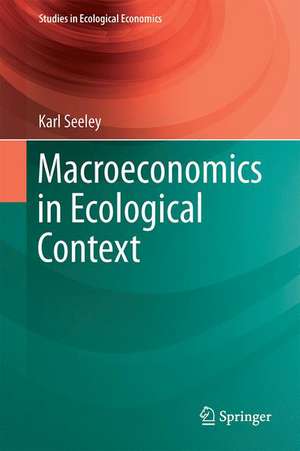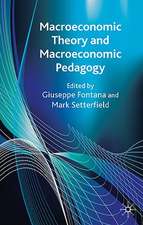Macroeconomics in Ecological Context: Studies in Ecological Economics, cartea 5
Autor Karl Seeleyen Limba Engleză Hardback – 17 feb 2017
| Toate formatele și edițiile | Preț | Express |
|---|---|---|
| Paperback (1) | 639.92 lei 38-44 zile | |
| Springer International Publishing – 13 iul 2018 | 639.92 lei 38-44 zile | |
| Hardback (1) | 741.68 lei 3-5 săpt. | |
| Springer International Publishing – 17 feb 2017 | 741.68 lei 3-5 săpt. |
Preț: 741.68 lei
Preț vechi: 904.49 lei
-18% Nou
Puncte Express: 1113
Preț estimativ în valută:
141.92€ • 148.57$ • 117.43£
141.92€ • 148.57$ • 117.43£
Carte disponibilă
Livrare economică 15-29 martie
Preluare comenzi: 021 569.72.76
Specificații
ISBN-13: 9783319517551
ISBN-10: 3319517554
Pagini: 374
Ilustrații: XX, 374 p. 88 illus., 5 illus. in color.
Dimensiuni: 155 x 235 x 28 mm
Greutate: 0.85 kg
Ediția:1st ed. 2017
Editura: Springer International Publishing
Colecția Springer
Seria Studies in Ecological Economics
Locul publicării:Cham, Switzerland
ISBN-10: 3319517554
Pagini: 374
Ilustrații: XX, 374 p. 88 illus., 5 illus. in color.
Dimensiuni: 155 x 235 x 28 mm
Greutate: 0.85 kg
Ediția:1st ed. 2017
Editura: Springer International Publishing
Colecția Springer
Seria Studies in Ecological Economics
Locul publicării:Cham, Switzerland
Cuprins
Part I Building Blocks.- 1. The Economy in the World.- 2. Resources and Economic Processes.- 3. Key Variables.- Part II The Long-run Model.- 4. Labor, Resources, and the Production Function.- 5. The Composition of Output.- 6. The Long-run Model (the Classical World). 7. Growth with Abundant Resources.- Part III Business Cycles.- 9. What Money Is.- 10 Banking .- 11 Expenditure Multipliers.- 12. Monetary Policy.- 13. Fiscal Policy.- 14. The IS and LM Curves.- 15. Policy and Shocks in the IS-LM World.- 16. Short-run Aggregate Supply / Aggregate Demand and Policy.- 17 Policy Assessment.- 18. The Standard Model and Alternative Perspectives.- 19. Resource Constraints.- 20. Growth under Resource Constraints.- 21. Business Cycles under Resource Constraints.- 22. Continuity and New Directions.
Textul de pe ultima copertă
Natural resources have been a recurring subject of public interest, from the environmental awakening in and the oil crises of the later 20th century, to wide swings in oil prices and increased concern about climate change in the first decades of the 21st century. Standard macroeconomics books treat resources in passing, in an ad hoc manner, if at all. This text integrates resources into the model from the ground up, allowing a more logically consistent understanding of the economic effects of changed resource availability. But the underlying structure remains mostly traditional: a full-employment perspective on the long run and a Keynesian approach to business-cycle fluctuations. This provides an easier adaptation for instructors and gives students the tools to understand economic analysis done in a more conventional framework. The business-cycle material starts with a “natural history” of money to help students see the connections between social and physical phenomena.
Caracteristici
Natural resources are integrated into conventional macroeconomic models for better comprehension of environmental-economy interactions, while preserving standard macroeconomic modes of analysis A “natural history” of money that makes for a smoother transition from the physical world of production to the social phenomenon of money A generally conversational style of writing for greater accessibility to students

























